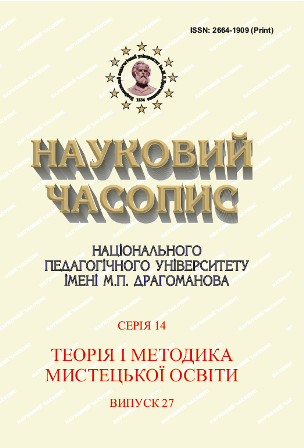Polyphonic music form of XX century as a type of composing and a way of thinking
DOI:
https://doi.org/10.31392/NPU-nc.series14.2019.27.22Keywords:
micropolyphony, music teacher, polyphony of timbres, rhythmic polyphonyAbstract
Relevance of the study. The polyphonic principle of creating and comprehending art images is manifested in all kinds of art. Musical polyphony is a kind of polyphonic voices, where individual voices are equally important in independent intonational rhythmic development. This requires the polyphonic thinking of a future music teacher. Today it is known that independent analysis and study of polyphonic works cause some difficulties for students. Literature review. The theory of polyphony in the system of musical thinking was studed by Y. Aliyev, G. Helmholtz, A. Dmitriev, Z. Rinkyavichyus, M. Reiterstein, G. Poberezhnaya, O. Polataiko, M. Sibiriakova–Khikhlovskaya, Xiao Li, I. Chizhik, T. Shcherytsya, K. Yuzhak and others. The problem of the development of polyphonic hearing was studied by G. Dubinin, A. Kauzova, T. Kurasov, G. Meliksetian, S. Perminova, V. Spiridonova, L. Stepanova and others. Modern polyphony is the content of scientific interest of M. Lobanova, S. Pavlyshyn, L. Kiyanovskaya, O. Kozarenko, N. Gulyanytska, B. Suta and others. Purpose – to clarify and highlight the main types of polyphonic writing of XX century music as a form of polyphonic thinking. Results. Music develops according to the laws of modern life. Therefore, the changes affected writing techniques, musical expressive means. The use of classical structures and types of polyphony (sub–voice, imitation, contrast) was especially individualized in the work of the twentieth century composers. Deep philosophical concepts become the main images of musical works containing juxtapositions of frets, techniques, timbres, rhythms, harmony, polyphony, the use of chords and more. The new stage in the development of musical art was characterized by linearity, which found a striking manifestation in the dodecaphonic system with a reliance on old–school technique. Musical art used a new type of writing that contained the following types of musical text: 1) line: melodic, rhythmic, timbral; 2) dot (or stroke): sound, rhythmic, timbre; 3) complex: cluster strip, layer, block (spot). Counterpoint – the fundamental principle of polyphony has undergone radical changes, interacting with new principles of formation, rhythmic, timbre colours, configurations of musical space. Counterpoint and imitation are virtually inseparable in the polyphony of dots – a natural consequence of pointillism. The polyphony of sonar layers is a layer branch of various realizations, a complex layer of musical fabric. Each layer of sonar polyphony in the collective ad libitum technique consists of several individual batches. Polyphony of styles allows practically any combination of them, even dissonance of styles especially sharp when they are in one sound plane. A clear innovation in the polyphony of the twentieth century was the presentation of thematic material: the theme is exhibited not in the form of a unanimous melodic line, but in the form of several lines that are heterophone. The fugue in the twentieth century continues to retain its importance of higher polyphonic form. Conclusions. We have identified the main types of polyphonic writing and types of texture of the twentieth century. Studying and performing polyphonic works by composers of different eras will help to form the students’ polyphonic thinking.
References
2. Zavgorodnyaya G. Polifonicheskie osnovy sovremennogo kompozitorskogo tvorchestva. Analiticheskie ocherki. [Polyphonic basics of contemporary composer creativity. Analytical essays]. Odessa : Astroprint, 2012. 308 s. [in Russian]
3. Zaverukha S. Polifoniia u strukturi systemy stupenevoi pidhotovky vchytelia muzyky, etyky i estetyky: posibnyk. [Polyphony in the structure of the system of step training of the music, ethics and esthetics teacher]. Khmelnyts. humanitar.-ped. akad. Khmelnytskyi : Zakolodnyi M. I., 2014. 243 s. [in Ukrainian]
4. Lobanova M. Muzykalnyy stil i zhanr: istoriya i sovremennost [Musical style and genre: History and modernity]. Serіya: Pismena vremeni. M: Tsentr gumanitarnykh initsiativ, 2015. 208 s. [in Russian]
5. Poberezhna H., Shcherytsia, T. Zahalna teoriia muzyky [General musical theory]: pidruchnyk. K. : Vyshcha shk., 2004. 303 s. [in Ukrainian]
6. Polataiko O., Xiao Li. Dialektychnyi aspekt formuvannia polifonichnoho myslennia studentiv-muzykantiv pedahohichnoho profiliu [Dialectical aspects of the formation of polyphonic thinking of students-musicians pedagogical]. Naukovyi chasopys Natsionalnoho pedahohichnoho universytetu imeni M.P.Dragomanova. Seriia 14. Teoriia i metodyka mystetskoi osvity: Zb. Nauk. Prats. K. : 2016. Vyp. 20 (25). S. 28-34. [in Ukrainian]
7. Skrebkov S. Teoriya imitatsionnoy polifonii [Theory of Imitation Polyphony]. Kiev : Muz. Ukraina, 1983. 144 s. [in Russian]
8. Snitkova I. Spetsifika "polifonicheskoy" struktury sverkhmnogogolosiya [The specificity of the "polyphonic" structure over polyphony]. Sovremennoe iskusstvo muzykalnoy kompozitsii: Sb. tr. GMPI im. Gnesinykh. Vyp.79. M., 1985. S.51-67. [in Russian]
9. Sposobin, I. V. Muzykalnaya forma [Musical form] : uchebnik obshch. kursa analiza. M. : Muzyka, 2007. 398 s. [in Russian].
10. Siuta B. Problemy orhanizatsii khudozhnoi tsilisnosti v ukrainskii muzytsi druhoi polovyny XX stolittia [Problems of organization of artistic integrity in Ukrainian music of the second half of XX century]. K. : NAN Ukrainy IMFE im. M. T. Rylskoho, 2004. 118 s. [in Ukrainian]
11. Xiao Li. Fenomen polifonichnoho myslennia v suchasnii muzytsi [The phenomenon of polyphonic thinking in contemporary music]. Pedahohichna maisternist yak systema profesiinykh i mystetskykh kompetentnostei: zb.materialiv XIII Mizhnar. Pedahohichno-mystetskykh chytan pamiati prof. O.P.Rudnytskoi / [holov.red.H.I.Sotska]. Vyp. 7 (11). K. : Talkom, 2016. S.272-276. [in Ukrainian]
12. Kholopova V. Voprosy ritma v tvorchestve kompozitorov 20 veka [The problem of rhythm in the work of the twentieth century composers]. Muzyka, 2003. 304 s. [in Russian]
13. Kholopova V.Faktura. M.: Muzyka, 1979. 87 s. [in Russian]
14. Yuzhak K. O prirode i spetsifike polifonicheskogo myshleniya [About the nature and specifics of polyphonic thinking]. Polifoniya. Sbornik statey. Sost. i red. K.Yuzhak. M. : Muzyka, 1975. S.6-62. [in Russian]

